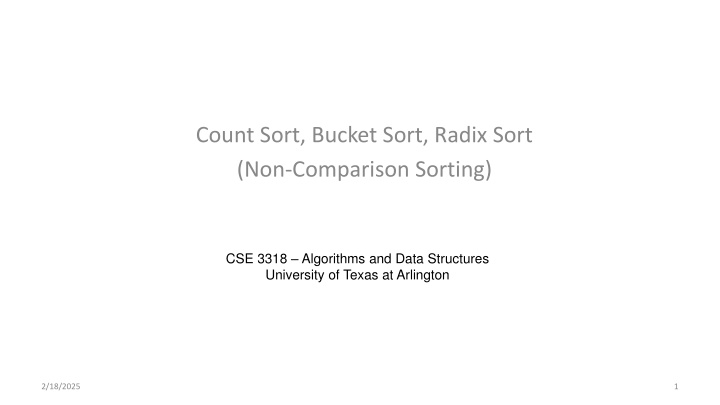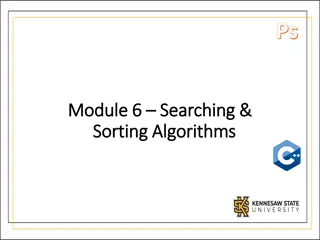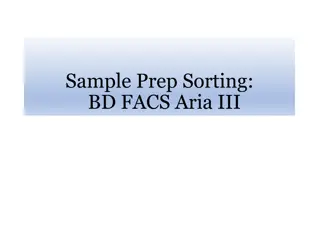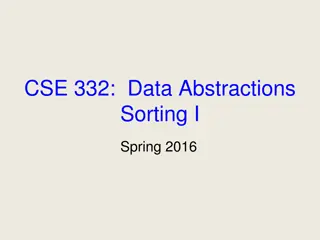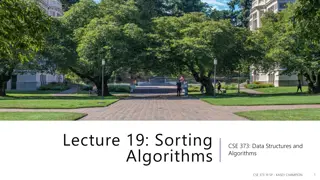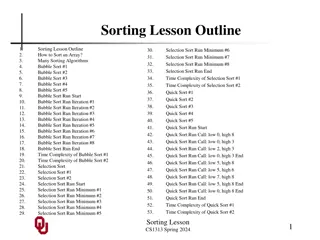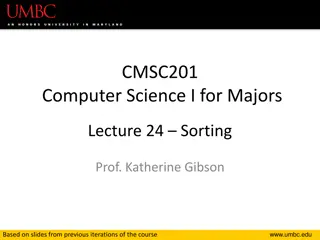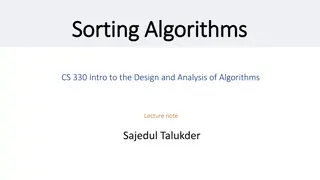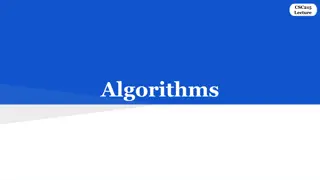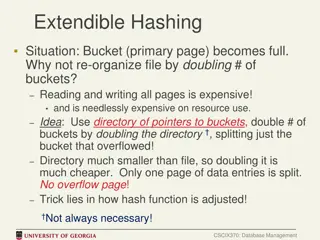Non-Comparison Sorting Algorithms: Count, Bucket, Radix Sort
Discover the efficiency of non-comparison sorting algorithms such as Count, Bucket, and Radix Sort in managing data structures. Dive into decision trees for comparison-based sorting algorithms and lower bounds on sorting techniques. An exploration of Count Sort's working, stability, adaptiveness, extra memory usage, time complexity, and suitability for diverse data types.
Download Presentation

Please find below an Image/Link to download the presentation.
The content on the website is provided AS IS for your information and personal use only. It may not be sold, licensed, or shared on other websites without obtaining consent from the author.If you encounter any issues during the download, it is possible that the publisher has removed the file from their server.
You are allowed to download the files provided on this website for personal or commercial use, subject to the condition that they are used lawfully. All files are the property of their respective owners.
The content on the website is provided AS IS for your information and personal use only. It may not be sold, licensed, or shared on other websites without obtaining consent from the author.
E N D
Presentation Transcript
Count Sort, Bucket Sort, Radix Sort (Non-Comparison Sorting) CSE 3318 Algorithms and Data Structures University of Texas at Arlington 2/18/2025 1
Non-comparison sorts Count sort Radix sort Bucket sort (uses comparisons in managing the buckets) Comparison-based sorting: (NlgN) lower bound 2
Lower-bounds on comparison-based sorting algorithms (Decision tree) covered if time permits A correct sorting algorithm must be able to distinguish between any two different permutations of N items. If the algorithm is based on comparing elements, it can only compare one pair at a time. Build a binary tree where at each node you compare a different pair of elements, and branch left and right based on the result of the comparison. => each permutation must be a leaf and must be reachable Number of permutations for n elements: n! => tree will have at least n! leaves. => height lg (n!) => height = (nlgn) (b.c. lg(n!) = (nlgn)) The decision tree for any comparison-based algorithm will have the above properties => cannot take less than (nlgn) time in the worst case. 3
Count Sort Based on counting occurrences, not on comparisons. See animation. Stable? Adaptive? Extra memory? Time Complexity? Does it work for ANY type of data (keys)? 3 Rui 0 Sam 2 Mike 2 Aaron 3 Sam 2 Tom 0 Jane Counts ( => position range) Sorted data 0 1 2 3 4 5 6 5
Count Sort Based on counting occurrences, not on comparisons. See animation. Stable? Yes Adaptive? No Extra memory? (N+k) Time Complexity? (N+k) For sorting only grades (no names), just counting is enough. Does it work for ANY type of data (keys)? No. E.g.: Sorting Strings, doubles 3 Rui 0 Sam 2 Mike 2 Aaron 3 Sam 2 Tom 0 Jane 1st count occurrences 2nd cumulative sum: curr = prev+curr 0 1 2 3 0 1 2 3 2 0 3 2 2 0 2 (=2+0) 3 5 (=2+3) 2 7 (=5+2) Sorted data; copy array 0 1 2 3 4 5 6 6
Original array, A: Init counts to 0 3 Rui 0 Sam 2 Mike 2 Aaron 3 Sam 2 Tom 0 Jane 0 1 2 3 0 0 0 0 0 1 2 3 4 5 6 Update with occurrences of each key 0 1 2 3 2 0 3 2 cumulative sum: counts[j]=counts[j-1]+counts[j]; 0 1 2 3 2 0 2 (=2+0) 3 5 (=2+3) 2 7 (=5+2) REPEAT sorted_copy array: 0 1 2 3 0 Jane t=6 1 2 5 7 0 1 2 3 4 5 6 0 1 2 3 A Jane 2 Tom t=5 1 2 4 7 0 1 2 3 4 5 6 0 1 2 3 A Jane C Tom 3 Sam t=4 1 2 4 6 0 1 2 3 4 5 6 7 Copy back from copy to A
Count sort (for an array of integers) // Assume array A has integers in the range [0,k] void countSort(int * A, int N, int k){ int counts[k+1]; int sorted_copy[N]; int j,t; for(j=0; j<=k; j++) // init counts to 0 counts[j]=0; for(t=0; t<N;t++){ // update counts counts[A[t]]++; } for(j=1; j<=k; j++) // cumulative sum counts[j]=counts[j]+counts[j-1]; for(t=N-1; t>=0;t--){ // copy data in sorted order in sorted array counts[A[t]]--; sorted_copy[counts[A[t]]] = A[t]; //counts[A[t]] holds the index (+1) where A[t] will be in the sorted array } for(t=0; t<N;t++) // copy back in the original array A[t] = sorted_copy[t]; } 8
Count sort: comparison with Insertion sort and usage Compare the time complexity of Selection sort and Count sort for sorting An array of 10 values in the range 0 to 9 vs An array of 10 values in the range 501 to 1500. - skip An array of 1000 values in the range 0 to 9 vs An array of 1000 values in the range 0 to 999 vs Algorithm/ problem N = 10, k = ___ In range 0 to 9 N = 10, k = _____ In range 501 to 1500 N = 1000, k = __ In range 0 to 9 N = 1000, k = ____ In range 0 to 999 Insertion sort (worst case) (N2) (__________) (___________) (___________) (___________) Count sort (N+k) (__________) (___________) (___________) (___________) When/for what data is count sort better? - Is there any desired relation between k and N? - Is there anything special (or needed) about the keys, this to work? - Can you think of data (keys) that count sort would not easily (possibly not at all) work for? 9
Count sort: comparison with Insertion sort Compare the time complexity of Selection sort and Count sort for sorting An array of 10 values in the range 0 to 9 vs An array of 10 values in the range 501 to 1500. -skip An array of 1000 values in the range 0 to 9 vs An array of 1000 values in the range 0 to 999 vs Algorithm/ problem In range 0 to 9 In range 501 to 1500 N = 10, k = 10 N = 10, k = 1000 N = 1000, k = 10 In range 0 to 9 N = 1000, k = 1000 In range 0 to 999 Insertion sort (worst case) (N2) (102) (102) (10002) (10002) Count sort (N+k) (10+10) = (10) (10+1000) = (1000) (1000+10) = (1000) (1000+1000) = (1000) Best performing method is in red. Note that this notation of (number) is not correct. I am showing it like this to highlight the difference in the values of N and k. 10
Example 2 Sort an array of 10 English letters. How big is the counts array? (k) (k = 26 possible key values letters) TC: (N+k) 11
Example 2 Sort an array of 10 English letters. How big is the counts array? (k) (k = 26 possible key values letters) TC: (N+k) 12
Functions to convert key to integer Function (no data structure used) Char (the key is a char): char-'A' E.g. 'D'-'A or grade-'A' ( In C you can subtract 2 chars (it uses their ASCII code) ) Integer (the key is an int): index = key-min_key (index for current key is given by the formula key-min_key) k = max_key-min_key+1 (possible different keys ) E.g .for keys (numbers) in range 501 and 1500: index = key-501 E.g. 501-501=0 so for key (number) 501, we go to index 0 in the counts array, and similar for 1500 we go to index 999 and for 700 we go to index 199 because: 1500-501=999, 700-501=199 Using a data structure will require (k) extra space Unsorted array, L, with all k possible keys and linear search for a key in the array and return the index -> TCkey2idx(A, k, key) = (k) (where |L|=k) Sorted array, S, of all possible k keys, and binary search in S to find the index for a key => TCkey2idx(S,k, key) = (log2(k)) (where |S| = k) HashTable (HashMap) , H, to map unique keys to indexes. HashTables will be covered later in the course. => TCkey2idx(H, k, key) = (1) amortized If can guarantee that no two different keys are hashed to the same index 13
Count sort usage What data can count sort be applied for: Values (keys) to be sorted must be integer values or chars (or be able to map to integers easily), It DOES work for negative values as well.E.g. for temperatures in range [-20, 50], the formula is temp- min_temp = temp - (-20). E.g. (-20)-(-20)= (-20)+20 = 0, (-15)-(-20)=5, 50-(-20) = 70 What data (keys) will count sort NOT be able to handle? - Real numbers (float, double). - Strings (generates very large k and it is non-trivial to uniquely map a string to an index) When is count sort better than worst case insertion sort? - The number of all possible keys (k) should be asymptotically smaller than N2 (written as k=o(N2) ). Ideally k is at most proportional to N (written: k=O(N) ) In a case when both insertion sort and count sort can be used, can you think of a reason why insertion sort would be preferred? If the best case of insertion sort (data is almost sorted) is likely Do not want to use the extra space of count sort Want an adaptive algorithm. k is very big How does count sort compare to the BEST case of insertion sort? Insertion sort is better: does not use extra space, and does less work in general (smaller dominant term) - 14
Least Significant Digit Radix Sort 15
LSD Radix Sort LSD radix sort (Least Significant Digit) Addresses the problem count sort has with large range, k. sorts the data based on individual digits, starting at the Least Significant Digit (LSD). requires a stable sort for sorting based on the digits 16
Sorting with radix sort for each digit i = 0 to d-1 (0 is the least significant digit) count_sort A using digit i as the key Known that values in A are in range: [0,999] => at most 3 digits A: {708, 512, 131, 24, 742, 810, 107, 634} ( Original array ) sort by units A: {810, 131, 512, 742, 24, 634, 107, 708} sort by tens A: {107, 708, 810, 512, 24, 131, 634, 742} sort by hundreds A: {024, 107, 131, 512, 634, 708, 742, 810} Here (in base 10): n = 8, d = 3, k=10 (0,1,2, 9) In base 2 (as numbers are stored): n=8, d=32 (for 4Bytes int), k=2 (bit: 0, 1) Implementation: How do you extract a digit from an integer in C? Use % and /. 17
LSD Radix Sort Complexity What are the quantities that affect the time and space complexity? What is the time and space complexity? Properties: - Stable? - Adaptive? 18
LSD Radix Sort Complexity What are the quantities that affect the time and space complexity? n is the number of items k is radix (or the base) d: the number of digits in the radix-k representation of each item. What is the time and space complexity? (d*(n+k)) time. ( (nd+kd)) d * the time complexity of count sort See the visualization at: https://www.cs.usfca.edu/~galles/visualization/RadixSort.html (n + k) space (for count sort). (n) space for scratch array. (k) space for counters/indices array. Properties (same as count sort): Stable yes (because count sort is) Adaptive - no 19
Example 3 Use Radix-sort to sort an array of 3-letter English words: [sun, cat, tot, ban, dog, toy, law, all, bat, rat, dot, toe, owl] 20
What type of data can be sorted with radix sort (that uses count sort)? For each type of data below, say if it can be sorted with Radix sort and how you would do it. Integers All positive __yes________ All negative ___yes, but careful about the sign, reverse order of magnitude (b.c. -34 is smaller than -1 ), there will be issues with % if working in base 10 Mixed ___no____________ Real numbers __ no (count sort does not work for them) Strings _____ yes, but non trivial for different lengths __________ (If sorted according to the strcmp function, where "Dog" comes before "cat", because capital letters come before lowercase letters). - yes Consider catapult compared with air - careful as cat and air must be compared, not ult and air 21
More on RadixSort - Extra So far we have discussed applying Radix Sort to the data in the GIVEN representation (e.g. base 10 for numbers). A better performance may be achieved by changing the representation (e.g. using base 2 or base 5) of each number. Next slide gives a theorem that provides: the formula for the time complexity of LSD Radix-Sort when numbers are in a different base and How to choose the base to get the best time complexity of LSD_Radix sort. (But it does not discuss the cost to change from one base to another) The next slide is provided for completeness, but we will not go into details regarding it. 22
Tuning Radix Sort Lemma 8.4 (CLRS): Given n numbers, where each of them is represented using b-bits and any r b, LSD Radix-sort with radix 2r, will correctly sort them in ( (b/r)(n+2r) ) if the stable sort it uses takes (n+k) to run for inputs in the range 0 to k. (Here the radix (or base) is 2r and each new digit is represented on r bits) How to choose r to optimize TC: r = min{b, floor(lg n)} (intuition: compare k with n and use the log of the smaller one) If b lg n => r = b If b > lg n => r = floor(lg n) Use as base min(2u, 2b), where 2u is the largest power of 2 smaller than n (2u n 2u+1) What is the extra space needed for each case above? (n+2r) (assuming it uses count sort as the stable sorting algorithm for each digit) 23
Bucket sort 24
TC practice Analyze time complexity to place N items in an array maintaining it sorted after each item is added. Same question for a single linked list. 25
Bucket Sort - Idea Bucket sort Idea: - Split the RANGE of keys into smaller ranges/intervals. Number of intervals = number of items in the array. - Each interval will have a corresponding bucket. - Copy each element in its corresponding bucket. Maintain the bucket sorted. - Copy back in original array in order of buckets Known: values in A are in range [0,1) Array A: 0.58 0.71 0.23 0.5 0.12 0.85 0.29 0.3 0.21 0.8 0.12 0.5 0.58 0.21 0.23 0.29 0.3 0.71 0.8 0.85 [0.0, 0.1) 0 [0.1, 0.2) 1 [0.5,0.6) 5 [0.6,0.7) 6 [0.2,0.3) 2 [0.3,0.4) 3 [0.4,0.5) 4 [0.7,0.8) 7 [0.8,0.9) 8 [0.9,1) 9 Array A: 0.12 0.21 0.23 0.29 0.3 0.5 0.58 0.71 0.8 0.85 Here all buckets are shown as same size, but their size should depend on the number of items in them (e.g. linked list). See animation : https://www.cs.usfca.edu/~galles/visualization/BucketSort.html 26
Index calculation Given an element in the array, A, how do we find the index, idx, of the bucket it should go to? [0,1) case when known that each element, elem, in A is in range [0,1) idx = floor(N*elem) general case: works when elements in A are in any range find min and max values in A idx = floor(? ???? min_? 1+max _? min_? 27
Index calculation - special case [0,1) Given an element in the array, A, how do we find the index, idx, of the bucket it should go to? [0,1) case when known that each element, elem, in A is in range [0,1) idx = floor(N*elem) Exercise 1: It is given that A has elements in range [0,1). A = {0.9, 0.71, 0.23, 0.05} Use formula:__________ N = ____ Compute indexes for these elements: Simulate bucket sort 28
Index calculation - general case Given an element in the array, A, how do we find the index, idx, of the bucket it should go to? general case: works when elements in A are in any range find min and max values in A idx = floor(? ???? min_? 1+max _? min_? coding issues Exercise 2: A = {2, 9, 7, 1, 8}, nothing else said about A. Use formula:__________ N = ____ Compute indexes for these elements: Simulate bucket sort 29
Bucket Sort Exercise 3: Give both an example of the data and the time complexity for: Best case: A=[___, ___, ___, ___ ] O( ) Explanation: Worst case: A=[___, ___, ___, ___, ___] O( ) Explanation: Array, A, has n numbers. version in the CLRS textbook assumes numbers in A are in the range [0,1) See animation: https://www.cs.usfca.edu/~galles/visualization/BucketSort.html Idea: Make as many buckets as number of items Place items in buckets . Maintain sorted buckets. Copy from each bucket into the original array bucket_sort(int * A, int N) Create array, B, of linked lists (bucket). Size of B will be N. For each list in B: initialize it to be empty Compute min_A, max_A For each elem in A, https://www.cs.usfca.edu/~galles/visualization/BucketSort.html Time complexity: -Best: (___) -Average: (___) -Worst case : (___) Worst case example: _________________ Space complexity: (____) (from: ) insert elem in sorted list B[idx] where idx = floor(? ???? min_? 1+max _? min_?) (if numbers in A are in [0, 1) you can use: idx = floor(elem*N) For each list in B: concatenate it (or copy back into A in this order). Destroy the list (if needed). Adaptive ____ Stable ____ 30
Bucket Sort - Practice Exercise 3: Give both an example of the data and the time complexity for: Best case: A=[___, ___, ___, ___ ] O( ) Explanation: Worst case: A=[___, ___, ___, ___, ___] O( ) Explanation: 31
Bucket Sort Array, A, has n numbers. version in the CLRS textbook assumes numbers in A are in the range [0,1) See animation: https://www.cs.usfca.edu/~galles/visualization/BucketSort.html Idea: Make as many buckets as number of items Place items in buckets . Maintain sorted buckets. Copy from each bucket into the original array bucket_sort(int * A, int N) Create array, B, of linked lists (bucket). Size of B will be N. For each list in B: initialize it to be empty Compute min_A, max_A For each elem in A, https://www.cs.usfca.edu/~galles/visualization/BucketSort.html Time complexity: -Best: (N) -Average: (N) -Worst case : (N2) (coming from worst case of insertion sort for longest list, size N) Worst case example (for N=10): 0.1, 0.11, 0.1001, 0.15, Space complexity: (N) (from: N pointes + N nodes) insert elem in sorted list B[idx] where idx = floor(? ???? min(?) 1+max(?) min(?)) (if numbers in A are in [0, 1) you can use: idx = floor(elem*N) For each list in B: concatenate it (or copy back into A in this order). Destroy the list (if needed). Adaptive yes Stable yes (depending on where a new node is inserted in a linked list) 32
Optional: Intuition for computing the bucket index How will you compute the index, idx, for the bucket for element A[k] out of N buckets? Let min = min element from A and max = max element from A. Use N buckets => indexes: 0,1,2, , (N-1) We want to map min to index 0 and max to index (N-1) min A[k] 1+max 1+max min A[k] Values range: idx N 0 Indexes range: 0 idx N ??? ?= ?[?] ??? 1+??? ??? ? ? ??? ? 1+??? ???) ??? = ?????( How does this formula compare with the one from https://www.cs.usfca.edu/~galles/visualization/BucketSort.html Do they make any assumptions about the data in the array? Is there any data that that formula would not work for? 33
Drawings of listArr at different stages in the program. Array of linked lists simple example /* assume new_node(), array_2_list(), and print_list_horiz() are the ones from the provided linked list implementation. */ typedef struct node * nodePT; truct node { int data; struct node * next; }; listArr created in line 1 listArr after loop in line 2 NULL 0 XXXX 0 NULL 1 XXXX 1 int arr[] = {5,1,8}; nodePT listArr[5]; //1 // size: 5*sizeof(memory address) = 5*8B=40B // use listArr[j] like any variable L or head (of type nodePT) NULL XXXX 2 2 NULL 3 XXXX 3 NULL 4 XXXX 4 // set every pointer/list to NULL for(j=0; j<5; j++) { // 2 listArr[j]=NULL; } listArr[0] = new_node(5); //4 listArr[2] = array_2_list(arr, 3); //5 print_list_horiz(listArr[0]); // Practice: create a new node with value 2 // and insert it at the beginning of // list at index 0. Update drawing. for(j=0; j<5; j++) { destroy_list(listArr[j]); //11 } listArr after lines 4 and 5 07cc 07cc 5 NULL 0 abcd 200c NULL dabc 1 1 NULL 5 dabc 200c 8 abcd 2 NULL 3 NULL 4 34
Range Transformations (Math review) Draw and show the mappings of the interval edges. [0,1) -> [0,n) if 0 : [a,b] - [ ,n) y = xn x a + = z n 1 b a [a,b) -> [0,1) -> [0,n) x y check, a As see that and 0 . n a- b- y a z = yn = b a Direct formula a for : [a,b) - [s,t) [a,b) -> [0,1) -> [s,t) x = + ( ) z t s s = + ( ) z y t s s b a check, a As see that and s . t a- b- What this transformation is doing is: bring to origin (a->0), scale to 1, scale up to new scale and translate to new location s. The order matters! You will see this in Computer Graphics as well. 36
Generic count sort Algorithm // Assume: k = number of different possible keys, // key2idx(key) returns the index for that key (e.g. 0 for letter A) // Records is a typename for a struct that has a key field void countSort(Records* A, int N, int k){ int counts[k]; Records copy[N]; for(j=0; j<k; j++) // init counts to 0 counts[j]=0; for(t=0; t<N;t++){ // update counts idx = key2idx(A[t].key); //assume key2index is (1) counts[idx]++; } for(j=1; j<k; j++) // cumulative sum counts[j]=counts[j]+counts[j-1]; for(t=N-1; t>=0;t--){ // copy data in sorted order in copy array idx = key2idx(A[t].key); //assume key2index is (1) counts[idx]--; copy[counts[idx]]=A[t]; //counts[idx] holds the index (+1) where A[t] will be in the sorted array } for(t=0; t<N;t++) // copy back in the original array A[t] = copy[t]; } 37
